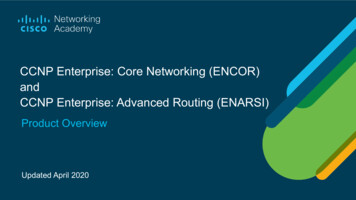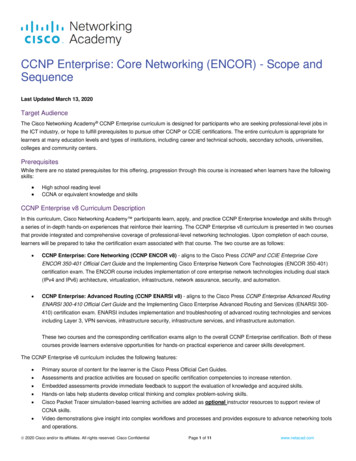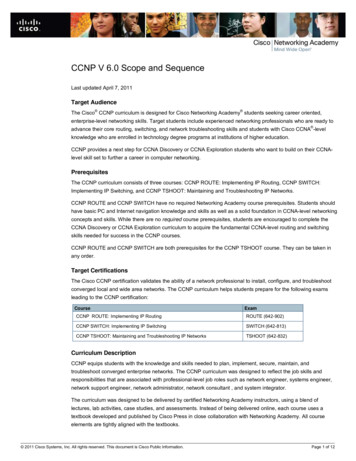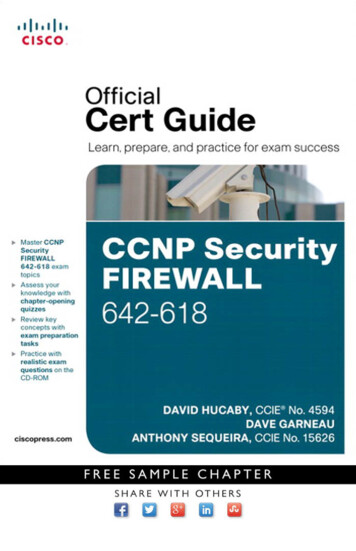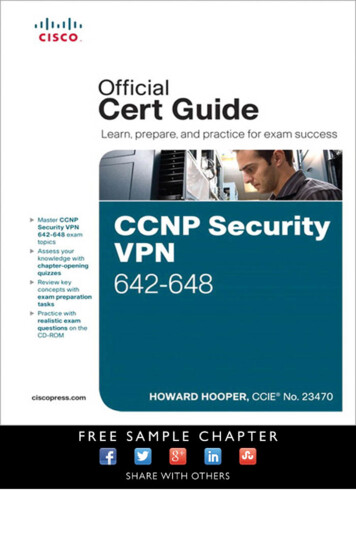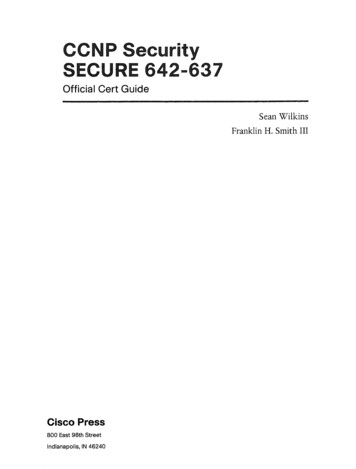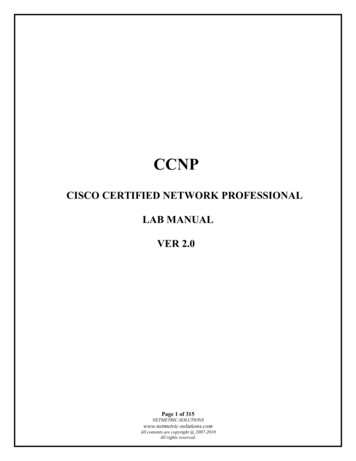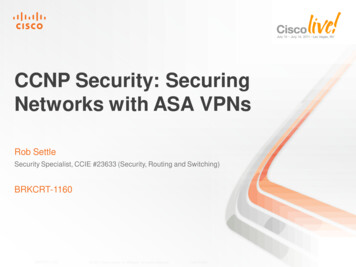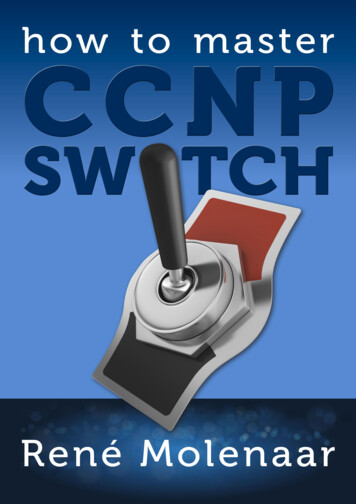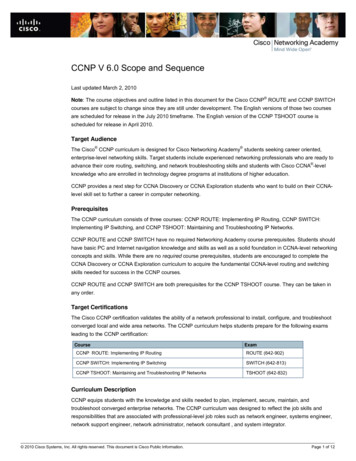
Transcription
CCNP V 6.0 Scope and SequenceLast updated March 2, 2010 Note: The course objectives and outline listed in this document for the Cisco CCNP ROUTE and CCNP SWITCHcourses are subject to change since they are still under development. The English versions of those two coursesare scheduled for release in the July 2010 timeframe. The English version of the CCNP TSHOOT course isscheduled for release in April 2010.Target AudienceThe Cisco CCNP curriculum is designed for Cisco Networking Academy students seeking career oriented,enterprise-level networking skills. Target students include experienced networking professionals who are ready toadvance their core routing, switching, and network troubleshooting skills and students with Cisco CCNA -levelknowledge who are enrolled in technology degree programs at institutions of higher education.CCNP provides a next step for CCNA Discovery or CCNA Exploration students who want to build on their CCNAlevel skill set to further a career in computer networking.PrerequisitesThe CCNP curriculum consists of three courses: CCNP ROUTE: Implementing IP Routing, CCNP SWITCH:Implementing IP Switching, and CCNP TSHOOT: Maintaining and Troubleshooting IP Networks.CCNP ROUTE and CCNP SWITCH have no required Networking Academy course prerequisites. Students shouldhave basic PC and Internet navigation knowledge and skills as well as a solid foundation in CCNA-level networkingconcepts and skills. While there are no required course prerequisites, students are encouraged to complete theCCNA Discovery or CCNA Exploration curriculum to acquire the fundamental CCNA-level routing and switchingskills needed for success in the CCNP courses.CCNP ROUTE and CCNP SWITCH are both prerequisites for the CCNP TSHOOT course. They can be taken inany order.Target CertificationsThe Cisco CCNP certification validates the ability of a network professional to install, configure, and troubleshootconverged local and wide area networks. The CCNP curriculum helps students prepare for the following examsleading to the CCNP certification:CourseExamCCNP ROUTE: Implementing IP RoutingROUTE (642-902)CCNP SWITCH: Implementing IP SwitchingSWITCH (642-813)CCNP TSHOOT: Maintaining and Troubleshooting IP NetworksTSHOOT (642-832)Curriculum DescriptionCCNP equips students with the knowledge and skills needed to plan, implement, secure, maintain, andtroubleshoot converged enterprise networks. The CCNP curriculum was designed to reflect the job skills andresponsibilities that are associated with professional-level job roles such as network engineer, systems engineer,network support engineer, network administrator, network consultant , and system integrator. 2010 Cisco Systems, Inc. All rights reserved. This document is Cisco Public Information.Page 1 of 12
The curriculum was designed to be delivered by certified Networking Academy instructors, using a blend oflectures, lab activities, case studies, and assessments. Instead of being delivered online, each course uses atextbook developed and published by Cisco Press in close collaboration with Networking Academy. All courseelements are tightly aligned with the textbooks.All hands-on labs in the course can be completed on actual physical equipment or in conjunction with the NDGNETLAB solution.CCNP course features: Designed for students with CCNA-level knowledge and skills Can be delivered as an independent curriculum or integrated into broader courses of study Offers a hands-on, career-oriented approach to learning networking that emphasizes practical experience Can be delivered in-person or in a blended distance learning (BDL) environment Includes activities that emphasize networking implementationCurriculum and Course ObjectivesCCNP helps students develop the skills needed to succeed in IT-related degree and diploma programs and preparefor the Cisco CCNP certification. It provides a theoretically rich, hands-on learning experience covering advancedrouting, switching, and troubleshooting skills.The goals of the CCNP curriculum are as follows: Provide an in-depth, theoretical overview of advanced routing and switching and troubleshooting Equip students with the knowledge and skills necessary to design and support complex enterprise networks Provide an experience-oriented course that employs industry-relevant instructional approaches to preparestudents for professional-level jobs in the industry Enable students to gain significant hands-on interaction with IT equipment to prepare them for certificationexams and career opportunitiesStudents who complete CCNP ROUTE will be able to perform the following tasks: Explain complex network requirements and design models for implementing advanced routing services in anenterprise network Implement EIGRP and OSPF in an enterprise network Implement various mechanisms for controlling routing updates and traffic Implement BGP to allow an enterprise network to connect to an ISP Describe a basic implementation for branch office and mobile worker connectivity Implement IPv6 in an enterprise networkStudents who complete CCNP SWITCH will be able to perform the following tasks: Implement, monitor, and maintain switching in an enterprise campus network Implement VLANs in campus networks Configure and optimize high availability and redundancy on switches Describe and implement LAN security features Plan and prepare for advanced services in a campus infrastructure 2010 Cisco Systems, Inc. All rights reserved. This document is Cisco Public Information.Page 2 of 12
Students who complete CCNP TSHOOT will be able to perform the following tasks: Monitor, maintain, and troubleshoot a complex network Plan and document the most common maintenance functions in complex enterprise networks Develop a troubleshooting process to identify and solve problems in complex enterprise networks Select tools that best support specific troubleshooting and maintenance processes in large, complexenterprise networks Practice maintenance procedures and fault resolution in switched and routed environments Troubleshoot IPv4 addressing services Troubleshoot IPv6 routing issues Troubleshoot network infrastructure services Troubleshoot network performance issues on routers and switches Troubleshoot network integration issues affecting wireless connectivity, VoIP, and video Practice maintenance procedures and fault resolution in a secure infrastructureMinimum System RequirementsGeneral curriculum requirements: 1 Student PC per student; 1 local curriculum server Lab equipment as defined per courseCCNP ROUTE Lab Bundle RequirementsThis course uses a lab bundle similar to that specified for the CCNP v5.0 Building Scalable Internetworkscurriculum. The lab bundle consists of four Cisco Integrated Services Routers, one Catalyst switch, and four studentPCs to represent network devices in a multisite, medium-sized business network. The equipment should be set upin the following configuration: 2010 Cisco Systems, Inc. All rights reserved. This document is Cisco Public Information.Page 3 of 12
QuantityDescriptionPart Number4Modular Router w/2xFE, 2 WAN slots, 32 FL/128 DRCISCO18414128 to 192MB SODIMM DRAM factory upgrade for the Cisco 1841MEM1841-64D 464MB Cisco 1800 Compact Flash MemoryMEM1800-64CF 52-Port Async/Sync Serial WAN Interface Card or T1 CardHWIC-2A/S or HWIC-2T5V.35 Cable, DTE Male to Smart Serial, 10 FeetCAB-SS-V35MT 5V.35 Cable, DCE Female to Smart Serial, 10 FeetCAB-SS-V35FC 1Catalyst 2960 24 10/100 2 1000BT LAN Base ImageWS-C2960-24TT-L4(Optional) Rackmount Kit for the 1841ACS-1841-RM-19 3PCs acting as clients/serversN/A3Ethernet cables4Ethernet cables (x-over)4Cisco IOS Release 12.4(20)T Advanced IP ional) Cisco CCP 1.3 or SDM 2.5Cisco-config-pro-expk9-1 3-en.zip SDM-V25.zipCCNP SWITCH Lab Bundle RequirementsThis course uses a lab bundle similar to that specified for the CCNP v5.0 Building Multilayer Switched Networkscurriculum. This lab bundle consists of four Catalyst switches and four PCs to represent network devices in amultilayer switched campus LAN. The equipment should be set up in the following configuration:QuantityDescriptionPart Number2Cisco Catalyst 3560-24PS EMI –24 ports – EN fast EN – 10BaseT100Base-TX 2 x SFP (empty)WS-C3560V2-24PS-E2Cisco Catalyst 2960-24TT – 24 ports – 10/100BTX 2x1000BaseTWS-C2960-24TT-L4PCs acting as clients/serversN/A4Ethernet cables12Ethernet cables (x-over)2Cisco IOS 12.2(46)SE Advanced IP Services (or better) for 3560s(K9-M image) 2010 Cisco Systems, Inc. All rights reserved. This document is Cisco Public age 4 of 12
2Cisco IOS 12.2(46)SE LAN base (or better) for 2960 (K9-M image)c2960-lanbasek9mz.122-46.SE.bin4Cisco CCP 1.3 or SDM 2.5 (Optional)cisco-config-pro-exp-k91 3-en.zipSDM-V25.zipCCNP TSHOOT Lab Bundle RequirementsThis course uses a modified combination of the topologies for the ROUTE and SWITCH courses. The NETLABMulti-Purpose Academy Pod (MAP) can be used to satisfy most labs by replacing the two 2960 distribution layerswitches in the topology with 3560 switches. The topology includes the 3560 switches DLS1 and DLS2. A switchhas been added between R1, R2, and R3, as with the ROUTE course. This switch can be simulated through theNETLAB control switch using the cabling shown. One of the PCs can be attached to R2 Fa0/1 for labs that mayrequire it. This can also be accommodated in NETLAB. The equipment should be set up in the followingconfiguration:QuantityDescriptionPart Number3Cisco IOS Release 12.4(20)T Advanced IP o IOS 12.2(46)SE Advanced IP Services (or better) for 3560s(K9-M image)c3560-advipservicesk9mz.122-46.SE.bin1Cisco IOS 12.2(46)SE LAN base (or better) for 2960 (K9-M image)c2960-lanbasek9mz.122-46.SE.bin3(Optional) Cisco CCP 1.3 or SDM 2.5cisco-config-pro-exp-k91 3-en.zipSDM-V25.zip 2010 Cisco Systems, Inc. All rights reserved. This document is Cisco Public Information.Page 5 of 12
Suggested SoftwareThe following software is also suggested for all three CCNP courses; however, Cisco cannot guarantee theavailability of the listed software from the manufacturerDescriptionManufacturerFirefox 2.0 and later versions, or Internet Explorer 6.0 and later versionsMozilla, MicrosoftTera Term Pro version 2.3 software terminal emulator for WindowsAyera PuTTY Terminal EmulatorFreewarehttp://www.chiark.greenend.org.uk/ sgtatham/putty/FreewareKiwi Syslog -overview/TFTP32 includes DHCP, TFTP, SNTP and Syslog servers as well as a TFTP clienthttp://tfpd32.jounin.net/FreewareWireshark network protocol analyzerFreewarehttp://www.wireshark.org/Cisco SDM requires Sun Java Runtime Environment (JRE)http://java.com/en/download/manual.jspSun Microsystems, Inc.(Free download)Curriculum OutlineChapterROUTE:Implementing IP RoutingSWITCH:Implementing IPSwitchingTSHOOT:Maintaining andTroubleshooting IP Networks1Routing ServicesAnalyzing the CiscoEnterprise CampusArchitecturePlanning Maintenance forComplex Networks2Configuring the EnhancedInterior Gateway RoutingProtocolImplementing VLANs inCampus NetworksTroubleshooting Processes forComplex Enterprise Networks3Configuring the Open ShortestPath ProtocolImplementing Spanning TreeUsing Maintenance andTroubleshooting Tools andApplications4Manipulating Routing UpdatesImplementing InterVLANRoutingMaintaining and TroubleshootingCampus Switched Solutions5Implementing Path ControlImplementing HighAvailability and Redundancyin a Campus NetworkMaintaining and TroubleshootingRouting Solutions6Implementing a BGP Solutionfor ISP ConnectivitySecuring the CampusInfrastructureTroubleshooting AddressingServices7Implementing RoutingFacilities for Branch Officesand Mobile WorkersPreparing the CampusInfrastructure for AdvancedServicesTroubleshooting NetworkPerformance Issues8Implementing IPv6 in theEnterprise NetworkTroubleshooting ConvergedNetworks9Maintaining and TroubleshootingNetwork SecurityImplementations10Review and Preparation forTroubleshooting ComplexEnterprise NetworksNote: The course objectives and outline listed in this document for CCNP ROUTE and CCNP SWITCH are subjectto change since they are still under development. 2010 Cisco Systems, Inc. All rights reserved. This document is Cisco Public Information.Page 6 of 12
CCNP ROUTE: Implementing IP RoutingThis course teaches students how to implement, monitor, and maintain routing services in an enterprise network.Students will learn how to plan, configure, and verify the implementation of complex enterprise LAN and WANrouting solutions, using a range of routing protocols in IPv4 and IPv6 environments. The course also covers theconfiguration of secure routing solutions to support branch offices and mobile workers. Comprehensive labsemphasize hands-on learning and practice to reinforce configuration skills.Course Prerequisites: None. CCNA-level knowledge and skills required.Chapter/SectionObjectivesChapter 1. Routing ServicesExplain complex network requirements anddesign models for implementing advancedrouting services in an enterprise network1.1 Assessing Complex Enterprise NetworkRequirementsDescribe common enterprise traffic requirementsand network design models1.2 Reviewing IP Routing PrinciplesReview the fundamentals of routing and comparevarious routing protocols1.3 Creating and Documenting an ImplementationPlanDescribe how to create an implementation plan forimplementing routing services in an enterprisenetworkChapter 2. Configuring the Enhanced InteriorGateway Routing ProtocolImplement EIGRP in an enterprise network2.1 EIGRP Capabilities and AttributesDescribe the basic functions and operation ofEIGRP2.2 Planning EIGRP Routing ImplementationsPlan and implement EIGRP routing2.3 Configuring and Verifying EIGRPVerify EIGRP routing2.4 Configuring and Verifying EIGRP in anEnterprise WANConfigure and verify basic EIGRP in an enterpriseWAN2.5 Configuring and Verifying EIGRP AuthenticationConfigure and verify EIGRP Authentication2.6 Optimizing EIGRP ImplementationsDescribe and configure EIGRP optimizationmechanisms; verify and troubleshoot the overallimplementationChapter 3. Configuring the Open Shortest PathFirst ProtocolImplement OSPF in an enterprise network3.1 Understanding OSPF Terminology andOperationDescribe OSPF terminology and operation withinvarious enterprise environments3.2 OSPF Packets3.3 Planning OSPF Routing ImplementationsPlan OSPF routing3.4 Configuring and Verifying Basic OSPFConfigure and verify basic OSPF3.5 Understanding OSPF Network Types, Link StateAdvertisements, and TablesDescribe and configure OSPF in various WANnetwork types3.6 Configuring and Verifying Advanced OSPFFeaturesConfigure and verify advanced OSPF features3.7 Configuring OSPF AuthenticationConfigure and verify OSPF authenticationChapter 4. Manipulating Routing UpdatesImplement various mechanisms for controllingrouting updates and traffic4.1 Assessing Network Routing Performance IssuesDescribe network performance issues and ways tocontrol routing updates and traffic 2010 Cisco Systems, Inc. All rights reserved. This document is Cisco Public Information.Page 7 of 12
4.2 Controlling Routing Update TrafficDescribe, configure, and verify various methods forcontrolling routing update traffic4.3 Using Multiple Routing Protocols on a NetworkDescribe the purpose of and considerations forusing multiple protocols in a network4.4 Implementing Route RedistributionConfigure and verify route redistribution of multipleprotocolsChapter 5. Implementing Path ControlImplement path control using IP SLA and PBR5.1 Understanding Path ControlDescribe how the various path control methodsaffect traffic5.2 Implement Path Control using Offset-ListsConfigure offset-lists for path control5.3 Implement Path Control using IP SLAConfigure the IP Service-Level Agreement featurefor path control5.4 Implement Path Control using Policy BasedRoutingConfigure policy-based routing (PBR) for pathcontrolChapter 6. Implementing a Border GatewayProtocol Solution for ISP connectivityImplement BGP to allow an enterprise networkto connect to an ISP6.1 Planning the Enterprise-to-ISP ConnectionDescribe the requirements for connecting anenterprise network to an ISP6.2 Understanding BGP Terminology and OperationDescribe basic BGP terminology and operation,including EBGP and IBGP6.3 Configuring and Verifying BGPConfigure and verify basic BGP6.4 Basic BGP Path Manipulation Using Route MapsDescribe and configure various methods formanipulating path selection6.5 Inbound and Outbound EBGP Path SelectionsDescribe and configure various methods formanipulating path selectionChapter 7: Implementing Routing Facilities forBranch Offices and Mobile WorkersDescribe a basic implementation for branchoffice and mobile worker connectivity7.1 Planning the Branch Office ImplementationDescribe the fundamentals of branch officeconnectivity7.2 Analyzing Services in the Branch OfficeDescribe the various services that can beimplemented for branch office connectivity7.3 Routing Traffic to the Branch OfficeDescribe the necessary configurations for a branchoffice to connect to an enterprise network7.4 Planning for Mobile Worker ImplementationsDescribe the fundamentals of mobile workerconnectivity7.5 Routing Traffic to the Mobile WorkerDescribe the necessary configurations for a mobileworker to connect to an enterprise networkChapter 8. Implementing IPv6 in an EnterpriseNetworkDescribe and configure IPv6 in an enterprisenetwork8.1 IPv6 Addressing in an Enterprise NetworkDescribe the basics of IPv6 addressing8.2 Assigning IPv6 AddressesDescribe and configure IPv6 addresses8.3 Routing IPv6 TrafficDescribe and configure IPv6 routing8.4 Tunneling IPv6 TrafficDescribe and configure IPv6 tunneling8.5 IPv6 Static and Dynamic NAT-PTDescribe and configure static and dynamic NAT-PT 2010 Cisco Systems, Inc. All rights reserved. This document is Cisco Public Information.Page 8 of 12
CCNP SWITCH: Implementing IP SwitchingThis course teaches students how to implement, monitor, and maintain switching in converged enterprise campusnetworks. Students will learn how to plan, configure, and verify the implementation of complex enterprise switchingsolutions. The course also covers the secure integration of VLANs, WLANs, voice, and video into campus networks.Comprehensive labs emphasize hands-on learning and practice to reinforce configuration skills.Course Prerequisites: None. CCNA-level knowledge and skills required.Chapter/SectionObjectivesChapter 1. Analyzing the Cisco EnterpriseCampus ArchitectureAssess the structure and components used tobuild or expand an enterprise campus network1.1 Campus Network Design PrinciplesDescribe common campus design options and howdesign choices affect implementation and support ofa campus LAN1.2 Applying the Lifecycle Approach to CampusDesignDescribe managing and supporting a campus LANusing a network life-cycles approachChapter 2. Implementing VLANs in CampusNetworksImplement VLANs in campus networks2.1 Implementing VLAN Technologies in a CampusNetworkGiven a large enterprise network design, plan VLANtechnologies, trunks, and addressing schemes tomeet business and technical requirements andconstraints2.2 Configuring VLANs and TrunksConfigure VLANs and VLAN trunks in a campusnetwork to support business and technicalrequirements2.3 Configuring Link AggregationGiven a design, addressing scheme, andbusiness/technical requirements and constraints,configure and verify Layer 2 EtherChannelChapter 3. Implementing Spanning Tree ProtocolImplement, monitor, and maintain spanning treeprotocol in an enterprise campus network3.1 Spanning Tree ProtocolsDescribe spanning tree protocols3.2 Configuring Spanning TreeGiven a network topology and business andtechnical requirements and constraints, configureand verify spanning tree protocols in a Layer 2topology that cont
2010 Cisco Systems, Inc. All rights reserved. This document is Cisco Public Information. Page 1 of 12
